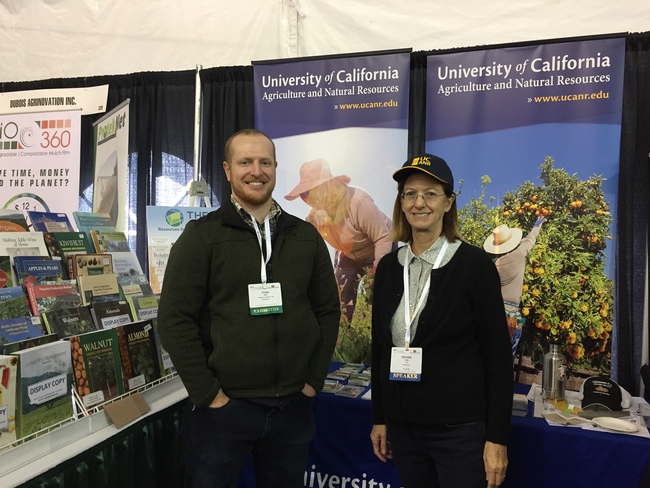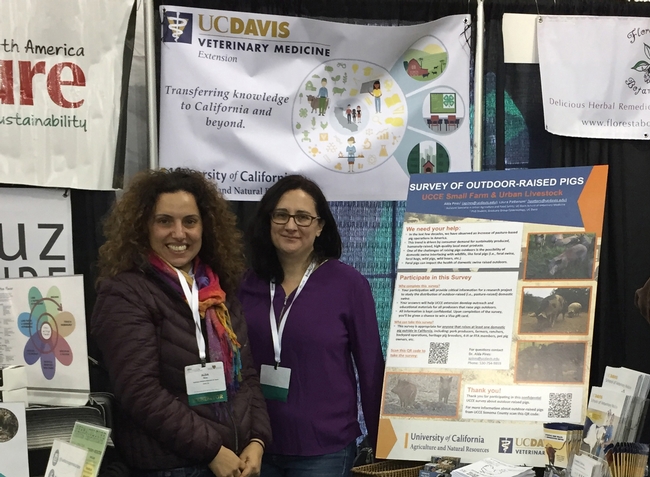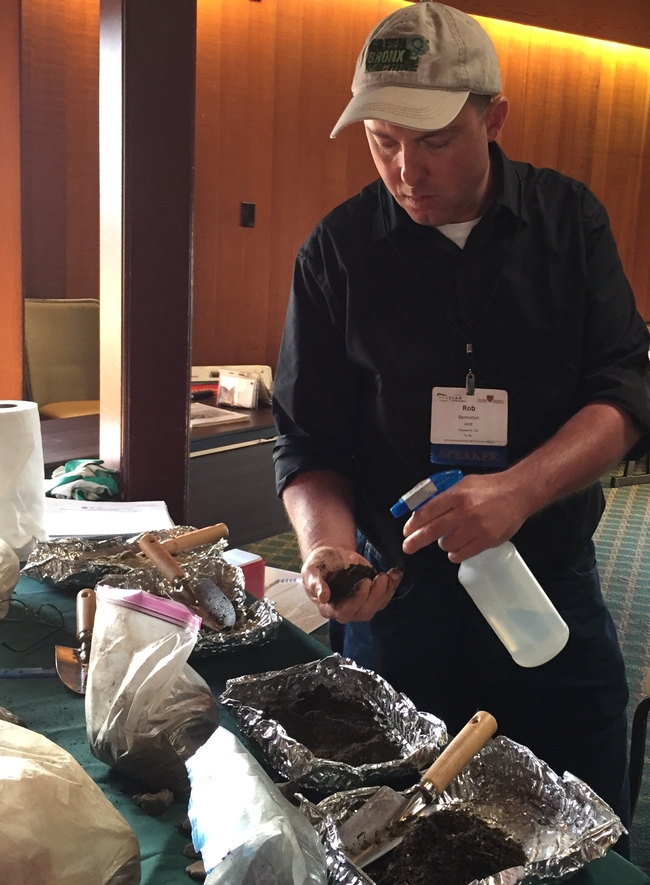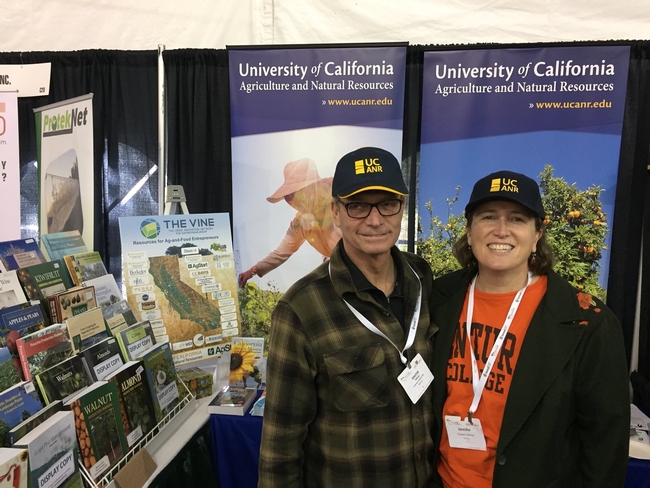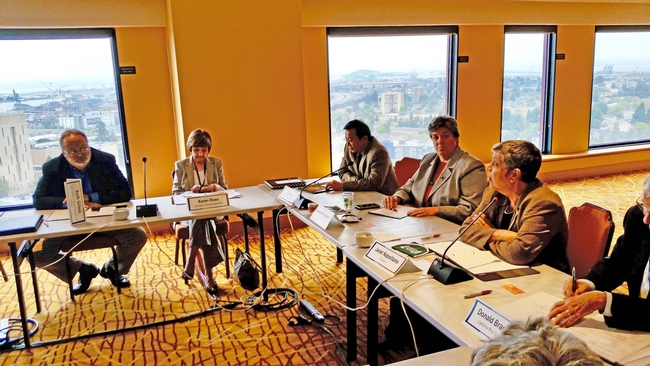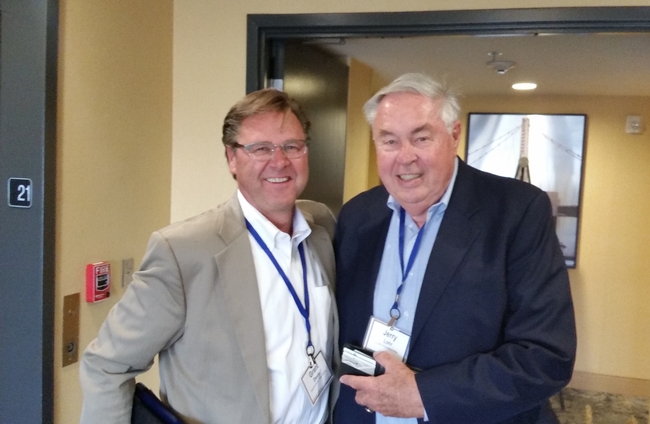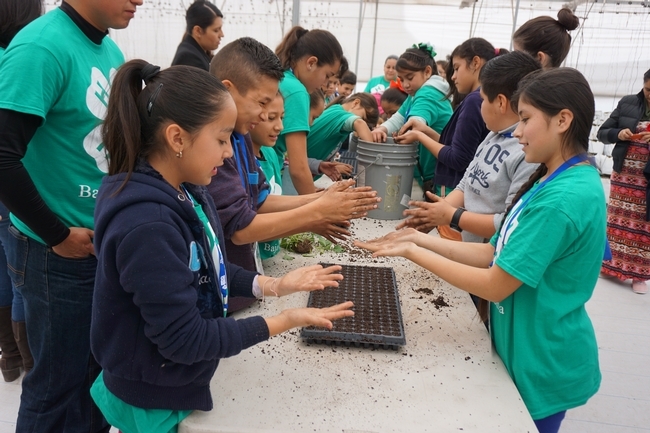Posts Tagged: Rob Bennaton
UC ANR meets new stakeholders at EcoFarm conference
Farmers, financiers, people from government agencies and nonprofit organizations who work with UC Cooperative Extension advisors, as well as beginning farmers seeking to contact their local UCCE advisors visited the UC ANR exhibit at the EcoFarm Conference Jan. 24-27 at Asilomar Conference Grounds in Pacific Grove.
Marketing assistant Tyler Ash apprised visitors perusing the racks of UC ANR publications of the resources available in their home counties and online.
Nearby, Alda Pires, UC Cooperative Extension specialist in the School of Veterinary Medicine at UC Davis, and Ph.D. candidate Laura Patterson had their own booth to meet people raising small livestock and discuss their research projects. Patterson is studying pigs raised outdoors and Pires studies farming systems using raw manure as fertilizer.
“Sow Good” was the theme of the 38th annual EcoFarm Conference, which focused on regenerative agriculture.
Outside the exhibit tent, breakout sessions enlightened participants on dozens of topics from soil health to organic production practices to marketing. Rachael Long, UC Cooperative Extension advisor in Yolo County, was one of three panelists discussing the benefits of hedgerows. Because hedgerows provide habitat for beneficial insects, fewer insecticide sprays are needed for adjacent tomato fields, according to her study. Long said the hedgerows saved growers $260 per field per year.
For backyard gardeners and urban growers, Rob Bennaton, UC Cooperative Extension urban agriculture advisor in the Bay Area, gave a talk on improving soil quality for growing food in urban areas. Before planting food crops in an urban plot, Bennaton advised the audience members to test the soil for contaminants such as lead, arsenic, chromium and mercury and to map where they sample the soil.
After listening to participants in one session discuss the efficacy of cats for rodent control – orange tabby cats were deemed most effective – one attendee remarked that meeting new people at events such as EcoFarm helps reveal opportunities for UC ANR outreach.
PAC discusses strategic plan and urban agriculture
Downtown Oakland was the site of the biannual UC President's Advisory Commission on Agriculture and Natural Resources (PAC) meeting on Aug. 9, which included a Q&A session with President Napolitano, program presentations from UC Cooperative Extension county directors Rob Bennaton and Igor Lacan, and updates from deans Helene Dillard (UC Davis), Keith Gilless (UC Berkeley) and Kathryn Uhrich (UC Riverside), as well as Executive Associate Dean John Pascoe (filling in for Dean Michael Lairmore, UC Davis School of Veterinary Medicine).
In her opening remarks, UC ANR Vice President Glenda Humiston introduced Mark Bell, the division's new vice provost for statewide programs and strategic initiatives. Bell spoke about the strength of the UC system, the diversity of programs offered by UC ANR statewide, and his plans to leverage the strong volunteer and staff base of programs like UC Master Gardeners and 4-H.
Humiston also offered updates on the division's strategic plan and the significant progress made in implementing its key goals. Associate Vice President Tu Tran then gave a presentation on the division's financial situation, which he titled “A Fiscal Plan for Success.” Tran addressed UC ANR's place in the state budget and its revenue projections through FY 2021-22, which includes significant growth in major gifts and fundraising.
Bennaton and Lacan both gave spirited and enthusiastic presentations that were received well. Bennaton, who serves as county director for Alameda and Contra Costa counties as well as UCCE urban agriculture advisor for the Bay Area, discussed the benefits of urban agriculture and the assortment of activities going on in community development, habitat restoration and youth programming.
Lacan, also a UCCE environmental horticulture advisor for the Bay Area and co-director in San Mateo and San Francisco counties, talked about the diverse and richly rewarding work he spearheads in urban forestry. His work currently focuses on sustainable management of urban trees and urban water.
During a Q&A period, the president engaged PAC members on various issues such as potential public-private partnerships that could involve UC ANR, targeted approaches to advocacy and deferred maintenance needs for UC writ large but also for UC ANR and its research and extension centers system, specifically.
The deans gave updates on research and activities occurring at their respective colleges and school.
The next PAC meeting is scheduled for December, also in Oakland.
AVP Powers announces 51 proposals invited for competitive and high-reward grants
AVP Wendy Powers announced the letters of intent (LOIs) for which principal investigators have been invited to submit full proposals to ANR's Competitive Grants Program and High-Risk/High-Reward Grants Program. The list of 51 approved projects can be found at http://ucanr.edu/sites/anrstaff/files/261626.pdf.
This year ANR received a total of 108 letters of intent — 97 for the Competitive Grants Program and 11 for the High-Risk/High-Reward Grants Program. Strategic Initiative leaders and their respective panels reviewed all letters of intent thoroughly to address the appropriateness of the proposals in addressing the goals and criteria outlined by each funding opportunity.
ANR Competitive Grants Program
The purpose of the ANR competitive grants program is to address high-priority issue areas identified by at least one of the strategic initiatives: Endemic and Invasive Pests and Diseases (EIPD), Healthy Families and Communities (HFC), Sustainable Food Systems (SFS), Sustainable Natural Ecosystems (SNE), and Water Quality, Quantity and Security (Water).
ANR Competitive Grants Program 2017 Cycle:
- Full proposals due June 19
- Technical peer review: mid-June – early September 2017
- Strategic Initiative review and recommendations: end of September 2017
- Program Council review and recommendations: October/November 2017
- Announcement of funded grants: November/December 2017
High-Risk/High-Reward Grants Program
Given the complexity of societal problems, high-risk research is necessary to achieve gains for real progress in addressing present and emerging challenges. This program will provide funds to initiate and complete research and proof-of-concept efforts that serve as the basis for larger funding opportunities. These projects must be of a high-risk/high-reward nature that are best conducted in a controlled, research setting and, if successful, lend themselves to subsequent larger funding opportunities and/or intellectual property development.
Proposed projects must be within the scope of the ANR Strategic Vision. All ANR academics with PI status are eligible to apply. Proposals will be accepted using the same timeline as outlined for the traditional competitive grants program, but reviewed separately due to the nature of the proposal.
For questions about ANR's competitive grants program or high-risk/high-reward grants program, please contact Melanie Caruso at mmcaruso@ucanr.edu.
Nutrition Policy Institute launches Research to Action news brief
The Nutrition Policy Institute has launched a news brief called Research to Action. The publication will provide information on research, policy, news, announcements, events, articles and action items focused on nutrition and healthy communities.
The first issue looks at the work of the National Drinking Water Alliance (NDWA). NPI is the “hub” for NDWA, which engages in and coordinates evidence-based efforts going on all over the country to improve tap water safety and access, especially for children, and to provide drinking water education and promotion. The NDWA website is a “go-to” resource for information on drinking water.
Future editions of Research to Action will be sent several times per year. Please sign up for the Research to Action mailing list, and please share Research to Action with colleagues who would be interested in receiving it.
4-H calls alumni and friends to join its new network
If 4-H has touched your life, raise your hand. Visit http://4-H.org/raiseyourhand to voice your support for the California 4-H youth development program, help it win a national competition and connect with a network of 4-H alumni and friends.
You are considered alumni if you were in a 4-H Club, took part in a 4-H after-school program, served as a volunteer leader or taught a project. Friends of 4-H are also invited to raise their hands.
“Having experienced our programs first-hand, our alumni know about the positive impact of 4-H,” said Glenda Humiston, vice president of UC Agriculture and Natural Resources and a 4-H alumna.
As part of the new 4-H network being built in the 4-H Raise Your Hand campaign, members will get news about 4-H programs in California and stay in touch with a program that made a difference in their lives.
“I've raised my hand,” said Humiston, who credits 4-H with helping her become the first in her family to attend college. She later served in the Peace Corps, received a federal appointment from President Obama and now leads the statewide research and outreach arm of UC.
The National 4-H program, which currently empowers nearly 6 million youth across the country, aims to extend its reach to 10 million by 2025. It has launched a competition among states to see which ones can add the most alumni and friends to the network by June 30, 2017. A map showing the current front runners is on the registration page.

